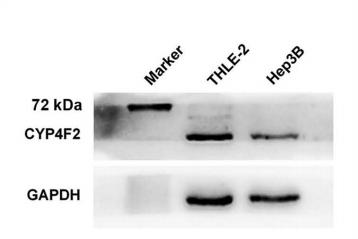CYP4F2 Antibody - #AF9051
| Product: | CYP4F2 Antibody |
| Catalog: | AF9051 |
| Description: | Rabbit polyclonal antibody to CYP4F2 |
| Application: | WB IHC |
| Cited expt.: | WB |
| Reactivity: | Human |
| Prediction: | Pig, Xenopus |
| Mol.Wt.: | 60kDa; 60kD(Calculated). |
| Uniprot: | P78329 |
| RRID: | AB_2843242 |
Related Downloads
Protocols
Product Info
*The optimal dilutions should be determined by the end user. For optimal experimental results, antibody reuse is not recommended.
*Tips:
WB: For western blot detection of denatured protein samples. IHC: For immunohistochemical detection of paraffin sections (IHC-p) or frozen sections (IHC-f) of tissue samples. IF/ICC: For immunofluorescence detection of cell samples. ELISA(peptide): For ELISA detection of antigenic peptide.
Cite Format: Affinity Biosciences Cat# AF9051, RRID:AB_2843242.
Fold/Unfold
Cyp4f14; CYPIVF1; Cytochrome P450 LTB omega; Cytochrome P450, family 4, subfamily F, polypeptide 2; EC 1.14.14.1; Leukotriene B(4) 20 monooxygenase; Leukotriene B(4) omega hydroxylase; MGC126966; MGC93476; P450 A3;
Immunogens
A synthesized peptide derived from human CYP4F2, corresponding to a region within N-terminal amino acids.
Liver. Also present in kidney: specifically expressed in the S2 and S3 segments of proximal tubules in cortex and outer medulla (PubMed:10660572).
- P78329 CP4F2_HUMAN:
- Protein BLAST With
- NCBI/
- ExPASy/
- Uniprot
MSQLSLSWLGLWPVAASPWLLLLLVGASWLLAHVLAWTYAFYDNCRRLRCFPQPPRRNWFWGHQGMVNPTEEGMRVLTQLVATYPQGFKVWMGPISPLLSLCHPDIIRSVINASAAIAPKDKFFYSFLEPWLGDGLLLSAGDKWSRHRRMLTPAFHFNILKPYMKIFNESVNIMHAKWQLLASEGSACLDMFEHISLMTLDSLQKCVFSFDSHCQEKPSEYIAAILELSALVSKRHHEILLHIDFLYYLTPDGQRFRRACRLVHDFTDAVIQERRRTLPSQGVDDFLQAKAKSKTLDFIDVLLLSKDEDGKKLSDEDIRAEADTFMFEGHDTTASGLSWVLYHLAKHPEYQERCRQEVQELLKDREPKEIEWDDLAHLPFLTMCMKESLRLHPPVPVISRHVTQDIVLPDGRVIPKGIICLISVFGTHHNPAVWPDPEVYDPFRFDPENIKERSPLAFIPFSAGPRNCIGQTFAMAEMKVVLALTLLRFRVLPDHTEPRRKPELVLRAEGGLWLRVEPLS
Predictions
Score>80(red) has high confidence and is suggested to be used for WB detection. *The prediction model is mainly based on the alignment of immunogen sequences, the results are for reference only, not as the basis of quality assurance.
High(score>80) Medium(80>score>50) Low(score<50) No confidence
Research Backgrounds
A cytochrome P450 monooxygenase involved in the metabolism of various endogenous substrates, including fatty acids, eicosanoids and vitamins. Mechanistically, uses molecular oxygen inserting one oxygen atom into a substrate, and reducing the second into a water molecule, with two electrons provided by NADPH via cytochrome P450 reductase (CPR; NADPH-ferrihemoprotein reductase). Catalyzes predominantly the oxidation of the terminal carbon (omega-oxidation) of long- and very long-chain fatty acids. Displays high omega-hydroxylase activity toward polyunsaturated fatty acids (PUFAs). Participates in the conversion of arachidonic acid to omega-hydroxyeicosatetraenoic acid (20-HETE), a signaling molecule acting both as vasoconstrictive and natriuretic with overall effect on arterial blood pressure. Plays a role in the oxidative inactivation of eicosanoids, including both proinflammatory and anti-inflammatory mediators such as leukotriene B4 (LTB4), lipoxin A4 (LXA4), and several HETEs. Catalyzes omega-hydroxylation of 3-hydroxy fatty acids. Converts monoepoxides of linoleic acid leukotoxin and isoleukotoxin to omega-hydroxylated metabolites. Contributes to the degradation of very long-chain fatty acids (VLCFAs) by catalyzing successive omega-oxidations and chain shortening. Plays an important role in vitamin metabolism by chain shortening. Catalyzes omega-hydroxylation of the phytyl chain of tocopherols (forms of vitamin E), with preference for gamma-tocopherols over alpha-tocopherols, thus promoting retention of alpha-tocopherols in tissues. Omega-hydroxylates and inactivates phylloquinone (vitamin K1), and menaquinone-4 (MK-4, a form of vitamin K2), both acting as cofactors in blood coagulation.
Microsome membrane>Peripheral membrane protein. Endoplasmic reticulum membrane>Peripheral membrane protein.
Liver. Also present in kidney: specifically expressed in the S2 and S3 segments of proximal tubules in cortex and outer medulla.
Belongs to the cytochrome P450 family.
Research Fields
· Metabolism > Lipid metabolism > Arachidonic acid metabolism.
· Metabolism > Global and overview maps > Metabolic pathways.
References
Application: WB Species: human Sample: THLE‑2 and Hep3B cells
Restrictive clause
Affinity Biosciences tests all products strictly. Citations are provided as a resource for additional applications that have not been validated by Affinity Biosciences. Please choose the appropriate format for each application and consult Materials and Methods sections for additional details about the use of any product in these publications.
For Research Use Only.
Not for use in diagnostic or therapeutic procedures. Not for resale. Not for distribution without written consent. Affinity Biosciences will not be held responsible for patent infringement or other violations that may occur with the use of our products. Affinity Biosciences, Affinity Biosciences Logo and all other trademarks are the property of Affinity Biosciences LTD.



